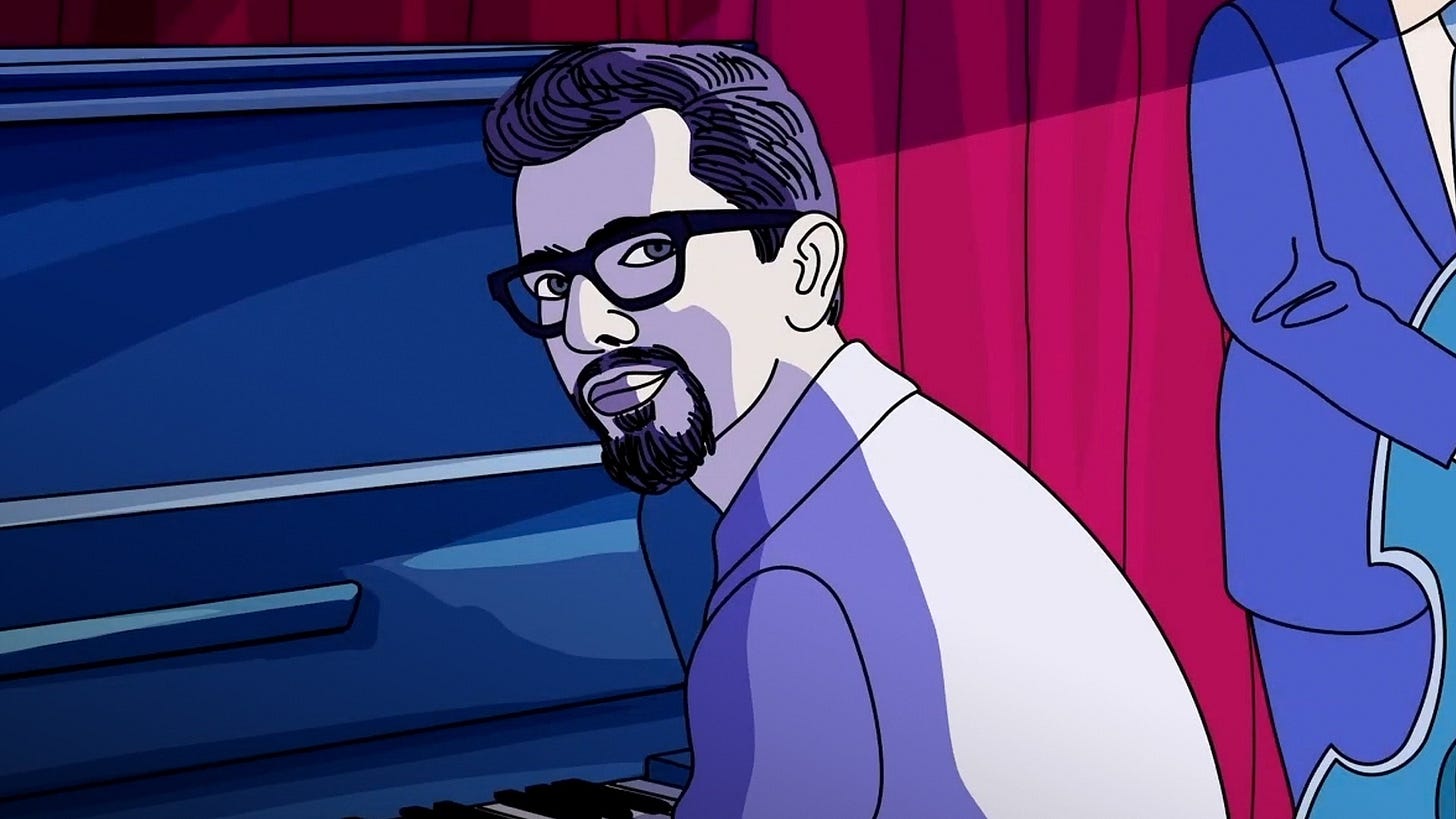They Shot the Piano Player
Jeff Goldblum is featured in this eclectic animated docudrama about the legacy of a Brazilian bossa nova pianist whose sudden disappearance left a scar that still lingers.
“They Shot the Piano Player” is an eclectic example of how animation can be used effectively aside from family-friendly entertainment. It’s a docudrama featuring Jeff Goldblum as an American novelist researching the life, music and mysterious death of a Brazilian bossa nova pianist.
It’s somewhat fictionalized, in that Goldblum’s character, Jeff Harris, is not a real person, a journalist who writes a book about the pianist. His talk at a New York City bookstore acts as the story’s framing device. Director Fernando Trueba, who co-wrote the script with Javier Mariscal, has also published a graphic novel that uses the same artwork style as the movie.
(As best I can determine, the graphic novel is based on the film and not the other way around.)
But Francisco Tenório Júnior was indeed a very real person who disappeared one night in Argentina in 1976 while going out to buy sandwiches. His presumed death left a huge scar among his family and fellow musicians that still lingers today. Though Harris isn’t real, he interviews the actual witnesses who talk about how much they cherished Tenório.
Tenório was not actually a huge name during his lifetime, even among fans of Brazilian music. The bossa nova wave that hit in the late 1950s and early ‘60s was a derivation of samba and jazz, influenced by Americans like Ella Fitzgerald and Chet Baker and in turn influencing the Yanks, with many U.S. artists putting out their own bossa nova albums during that time.
Tenório was a member of other people’s bands but only produced one record of his own at the tender age of 23. Harris hears his playing on somebody else’s record and is fascinated by his style, smooth and intricate without ever becoming the fussy “floater” music memorably derided in “The Commitments.”
Commissioned by a friend/publisher (Roberta Wallach) to go to Rio de Janeiro to research a book about the origins of bossa nova, Harris keeps poking into the story of Tenório and is fascinated by how all the samba greats speak so glowingly of him as a musician — the best jazz pianist in Brazil is an oft-repeated phrase — and as a gentle, pure, almost childlike person.
The title of the graphic novel and movie is a play on the French New Wave Classic “Shoot the Piano Player,” and the film is filled with references to that cinema as being a touchstone to the artists of Brazil. Soon after a military dictatorship slammed down on these free-thinkers, and people began disappearing from the streets to be tortured and murdered.
The American government was unfortunately involved in these repressions all over Central and South American in a little-known initiative known as Operation Condor. Tenório, while visiting in Argentina, was apparently swept up by mistake simply because of his long hair and beard. Once the authorities realized who they had in custody, the realized they couldn’t release him without him telling his story.
Interestingly, the film never features Tenório speaking himself, only others talking about him. It makes him an intriguing figure, the mystery man at the center of the story who communicates only through his music.
His life was complex. He and his wife, Carmen, had five children and it seems he was a happy family man, despite never having very much money. Nonetheless, he also had a girlfriend, Malena, and it was she he was with when he left their hotel in the middle of the night because she was hungry. He just never returned.
The animation style is very much like a motion comic, with drawn images that change a little bit and slide across the screen, almost like a mix of stop-motion animation and puppetry. The colors are subdued, vibrant blues and purples, especially for the flashback sequences that are mostly at night.
I was delighted by an early sequence featuring Ella Fitzgerald stumbling onto the beginnings of bossa nova, pushing through a nightclub crowd to take the stage, kick off her shoes and start scatting delightfully. It’s one of those ‘maybe it’s true, maybe it’s not, but you wished it happened’ sort of scenarios.
“They Shot the Piano Player” does bog down somewhat in the last third or so as it moves away from Tenório the person and artist and becomes more of a politics-heavy investigation/denunciation. The final disposition of the pianist is eventually revealed, and it’s of no surprise to anyone — just one of tens of thousands of people snatched up and killed off for no good reason at all.
Still, this is a delightful and engrossing account of one heretofore forgotten piano player who will not be allowed to fade into obscurity.





